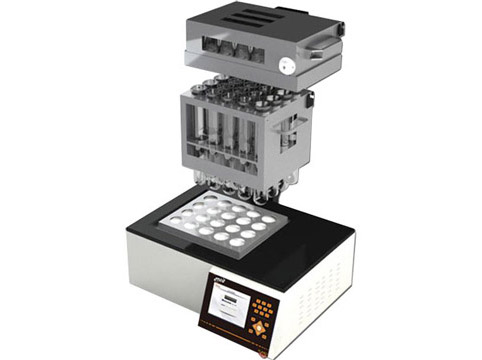Sample digestion in chemistry is the process of breaking down a sample of a solid material into smaller pieces, through the use of a combination of heat and chemicals, in order to make it easier to analyze the composition of the sample. This process is typically done in a laboratory setting and is an important step in many analytical chemistry techniques, such as atomic absorption spectroscopy or inductively coupled plasma mass spectrometry. Digestion methods vary depending on the type of sample, the analysis technique and the regulatory requirements.
Uses
There are several methods of sample digestion commonly used in laboratory, including:
Dry block:the method of sample digestion with a tube block heater is a technique used in laboratory to digest a sample by heating it in test tube, using a tube block heater. The tube block heater is a device that is designed to heat multiple test tubes at the same time and maintain a consistent temperature throughout the heating process.
In this method, the sample is placed in a test tube, along with a combination of acids and/or oxidizing agents, and then the test tube is sealed and placed in the tube block heater. The heater is then set to a specific temperature and time, and the sample is heated until the desired level of digestion is achieved. The tube block heater allows for consistent heating of the sample and more precise control of the temperature and heating time, making this method useful for samples that are sensitive to high temperatures or that require precise conditions for optimal digestion.
A waste gas collection hood is often used in conjunction with a digestion block, a device used for sample digestion, to ensure the safe and efficient operation of the digestion process. The hood is designed to capture any gases or fumes that are produced during the digestion process and direct them away from the operator.
The main reason for using a waste gas collection hood is safety. Many of the reagents used in sample digestion, such as acids and oxidizing agents, can produce hazardous fumes that can be harmful if inhaled. A waste gas collection hood can capture these fumes and prevent them from reaching the operator, reducing the risk of exposure to hazardous materials.

Microwave digestion: This method involves the use of microwave energy to rapidly heat the sample and dissolve it in a combination of acids.
The choice of acid and oxidizing agents depends on the type of sample and the analysis technique that is going to be used.
Wet oxidation: This method involves the use of strong oxidizing agents, such as nitric acid or hydrogen peroxide, to oxidize the sample and convert it into a soluble form.
Dry ashing: This method involves heating the sample in a muffle furnace until all organic matter is burned off and the sample is left as a dry ash.
Acid digestion: This method uses a combination of mineral acids, such as hydrochloric acid or sulfuric acid, to dissolve the sample.
Fusion: This method involves the use of a combination of heat and a flux, such as sodium peroxide or lithium tetraborate, to melt the sample and dissolve it in a liquid.
Pressurized hot water extraction (PHWE) : This method uses high pressure, high temperature water to extract the sample and dissolve it in a liquid.
Solvent extraction: This method uses a solvent to dissolve the sample and extract the desired components.
The choice of method depends on the type of sample, the analysis technique and the regulatory requirements.
The digestion procedure is a set of steps followed to break down a sample of solid material into smaller pieces, often through the use of heat and chemicals, in order to make it easier to analyze the composition of the sample. The specific steps of the digestion procedure can vary depending on the type of sample, the analysis technique, and the method of digestion being used. A general outline of the procedure is given below:
Sample preparation: The sample is prepared for digestion by measuring the appropriate amount, homogenizing or finely grinding, and if necessary drying the sample to a constant weight.
Reagent preparation: The appropriate reagents (acid, oxidizing agents, fluxes or solvents) are prepared, as per the method chosen, and added to the sample.
Digestion: The sample is placed in a sealed container, such as a test tube, and heated to the desired temperature for a specific time. The temperature and time may vary depending on the method of digestion and the type of sample.
Cooling: After the digestion is complete, the container is allowed to cool to room temperature.
Dilution: If necessary, the sample is diluted with an appropriate solvent or water before analysis.
Analysis: The composition of the sample is analyzed using the appropriate analytical technique.
It's important to note that safety precautions should be taken when handling the reagents, the samples and the apparatus.